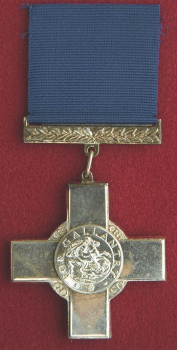
GEORGE CROSS (VC)
The cross was awarded for an act of the greatest heroism or of the most
conspicuous courage in circumstances of extreme danger. It was intended primarily
for civilians and award in the military services was confined to actions for which
purely military honours were not normally granted and awarded for actions not in the
face of the enemy.
The Empire Gallantry awards were exchanged for the George Cross, and
in
1971, Albert Medal winners exchanged their medals for the George Cross.
BAR
A bar was to be awarded for additional acts of gallantry; none were
ever issued.
DESCRIPTION
A silver Geneva Cross, 1.8 inches wide.
OBVERSE
In the centre of the cross is a circular medallion showing St. George
slaying the dragon and around this an annulus bearing the legend FOR GALLANTRY.
In the angle of each limb of the cross, the Royal Cypher GVI forming a
circle concentric with the medallion.
REVERSE
The reverse is plain except for the naming.
MOUNTING
A straight silver, laurel bar, slotted for the ribbon, with a ring
lug below, made in one piece is joined to the cross by a small silver ring
which passes through the ring lugs of the bar and the top of the medal.
NAMING
The name, rank and service (serial number for those not commissioned)
and the date of notification in the London Gazette are shown on the reverse
of the cross.
RIBBON
The garter blue ribbon is 1.5 inches wide. A miniature cross is worn
on the ribbon in undress. Women may wear their cross from a bow.
DATE
The George Cross was created on 24 September 1940 and published in
the London Gazette on 31 January 1941.
![]()
~Squadrons~
~Order of
Battle~ ~Airfields~ ~Aircraft~ ~Daily
Operations~ ~Stats~ ~Strike
Photos~ ~Mining
Codes~ ~Home~
~Sign
My Guestbook~ ~View
My Guestbook~